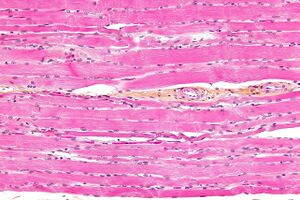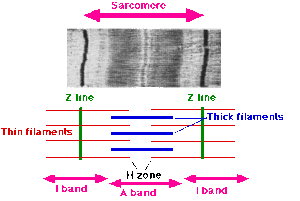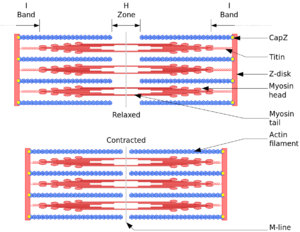Skeletal Muscle
Skeletal muscle consists of 40-50% of total body mass. It is composed of muscle cells, organised networks of nerves and blood vessels, and an extracellular connective tissue matrix. The framework helps to support and protect the structure against injury. It is organised into individual units into tissues and organs that contract to produce joint motion and locomotion.
Overview
The physiology of muscle cell activation and deactivation is summarised as follows:
- A single electrical impulse passes down an axon to its motor end plates
- Chemical transmission occurs at the synapses
- Electrical potentials are generated in the muscle membranes
- The electrical potentials pass along the muscle surface and into the fibres via the transverse tubules
- Calcium is released from the sarcoplasmic reticulum
- Calcium binds to the thin filaments and causes a conformational change allowing interaction between thick and thin filaments
- ATP is hydrolysed providing the energy for the sarcomeres to shorten or to resist stretch by pulling the thin filaments arrays into the thick filament arrays.
- With interaction of contractile proteins muscle contraction occurs along with force production
- Through costameres, the majority of force production is transmitted laterally to surrounding myofibrils
- With muscle relaxation there is active transport of calcium into the longitudinal tubules of the sarcoplasmic reticulum.
- Calcium is dissociated from troponin and a conformational change occurs in tropomyosin preventing further cross-bridge attachment.
Histology and Cytology
Muscle fibres are a syncytium of many cells fused together with multiple nuclei to form single long "cells". Muscle fibres contain numerous tubular myofibrils, which in turn are composed of repeating sections of sarcomeres. Sarcomeres are seen in both cardiac and skeletal muscle.
Muscle fibres are arranged in either a parallel or oblique direction along the long axis of the muscle. Oblique orientation is seen in pennate, bipennate, multipennate, and other more complex fibre arrangements.
Muscle fibres are surrounded by connective tissue which binds the contractile units together. The endomysium surrounds individual fibres and is delicate. The fibres are arranged into fascicles, which are visible to the naked eye. Fascicles are surrounded by perimysium. Epimysium loosely surrounds the whole muscle to allow for length changes. Blood vessels are also found within connective tissue.
At the cellular level, muscle fibres are surrounded by the sarcolemma which is the plasma membrane. External to the sarcolemma is the basement membrane. The basement membrane has an inner layer called the lamina rara or lucida, and an outer denser layer called the lamina densa. The basement membrane merges with the reticular layer and the extracellular matrix.
The basement membrane consists of several protein and carbohydrate components produced by the muscle fibre and fibroblasts. The principal components are collagen, laminin, fibronectin, and other specific glycoproteins. The endomysium consists of the basement membrane, reticular layer, and the close layer or matrix and collagen fibres. It has a good capillary supply.
Each muscle fibre has numerous nuclei, and these are generally found at the periphery of the fibre just under the sarcolemma. There are also satellite cells on the surface of the muscle which are thought to be stem cells.
Within the muscle fibre is the sarcoplasm which is similar to the cytoplasm of other cells. It contains a cellular matrix and organelles, and is exclusive of the nuclei. The important organelles are the Golgi apparatus, mitochondria, and the sarcoplasmic reticulum. The sarcoplasmic reticulum is a continuous membrane that is analogous to the endoplasmic reticulum of other cells. Within the sarcoplasm there are also lipid droplets, glycogen, and myoglobin.
The sarcomeres is the basic structural unit of striated muscle, and under microscopy appear as alternating dark and light bands.
Nerve-Muscle Interaction
Nerves enter the muscle at the motor point of skeletal muscle. The axons of each nerve cell branch several times, and in doing so every muscle fibre is contacted by a single nerve terminal. The point of contact is called the motor end plate, and it is here where we see cellular communication between the nervous system and skeletal muscle.
The sum of a single nerve axon and all the muscle fibres that it contacts is called the motor unit. Muscle fibres within a single motor unit are not always adjacent, and adjacent muscle fibres can belong to different motor units. There are a variable number of muscle fibres within a motor unit and number of motor units within a muscle.
- The extraocular muscle require fine motor control and may have 10 muscle fibres per motor unit. The gastrocnemius muscle on the other hand has more than 1000 muscle fibres per motor unit.
- A motor units size is also related to the size of the motor axon as well as the size of the cell body within the ventral horn of the spinal cord.
- The size of a motor unit is additionally related to the type of muscle fibre.
Motor units are stimulated to induce contraction through an action potential that arises from the cell body of the nerve. The action potential is propagated down the axon from the ventral horn to the skeletal muscle. At the motor end plate the electrical signal from the nerve is transformed, through an in-between process of chemical transmission, into a similar electrical signal within the membrane of the muscle fibre. Chemical transmission occurs across the synapse of extracellular space between the two membrane systems.
The axon of the efferent motor nerve loses its myelin sheath as it approaches the motor end plate. The terminal axon is covered instead by a Schwann cell, which is a connective tissue cell. The nerve terminal spreads out over the muscle membrane and this is called the sole plate. The axon terminal and muscle membrane form interdigitations of membrane called primary synaptic folds. This amplifies the surface area between nerve and muscle. The nerve and muscle membranes are not in direct contact. The synaptic cleft is the space between the nerve and muscle membranes and is around 50nm in size. It is within this synaptic cleft that chemical transduction occurs.
Acetylcholine is the key neurotransmitter and this is stored in the presynaptic axon in vesicles. When an action potential arrives at the terminal axon, there is an influx of calcium into the cell, which causes the vesicles to fuse with the terminal axon membrane, and calcium is released into the synaptic cleft. The acetylcholine diffuses across the synaptic cleft and binds to a receptor on the muscle membrane surface.
When acetylcholine binds to the receptor on the muscle membrane surface, current flows into the muscle and depolarises the membrane. This triggers an action potential that passes through the muscle membrane similar to the action potential in nerves.
Acetylcholine is deactivated by acetylcholinesterase and other less specific enzymes in the extracellular space and basement membrane. The breakdown products can be reabsorbed by the terminal axon for resynthesis.
The neuromuscular junction is important in several pharmacological and disease processes
- Paralytic agents: Tubocurarine binds to acetylcholine receptors inhibiting impulse transmission. Succinylcholine and other compounds exert a similar effect through initial temporary depolarisation then failure of impulse transmission.
- The pathophysiology of Myasthenia gravis is related to a insufficient number of acetylcholine receptors due to an autoimmune process. Cholinesterase inhibitors increase the half life of acetylecholine.
- There are various toxic nerve gases and insecticides that cause irreversible cholinesterase function.
Muscle contractile force is increased by by both increasing the frequency of stimulation to make the same motor units work harder, and by recruiting more motor units. There is an ordered an sequential recruitment of motor units and regulation of activation frequency. This allows for optimising of muscle contraction and limb motion.
Muscle Membrane System
With the onset of depolarisation at the end plate, the electrical impulse propagates down the muscle membrane and reaches the interior of the cell through an intricate membrane system. This intricate system allows communication of surface signals into the deep regions of the muscle fibre, allowing rapid signal impulse transmission throughout the cell.
Transverse tubules are a key feature of this system. Transverse tubules are usually oriented in a perpendicular direction to the long axis of the cells. They penetrate from the surface of the fibres near the A-band and I-band junction. These tubules interact with the sarcoplasmic reticulum which actively accumulates calcium from the sarcoplasm and stores it inside itself, and therefore out of the sarcoplasm.
With the arrival of an electrical impulse from within the muscle membrane and tubular system, there is a momentary release of calcium from within the sarcoplasmic reticulum, into the sarcoplasm of the muscle cell. It is this calcium release that is the trigger leading to the interaction of contractile proteins for force generation.
This intricate system, containing the membrane system, surface membrane, transverse tubules, and sarcoplasmic reticulum, aids in concurrent release of calcium and therefore synchronised interaction of muscle proteins and force generation.
The sarcoplasmic reticulum has different components. The region next to the transverse tubules is termed the junctional sarcoplasmic reticulum. Two sacs of junctional reticulum along with the transverse tubule is termed a triad. There are bridging structures connecting these three separate membrane systems. Electrical impulses cause calcium release from the junctional sarcoplasmic reticulum. Other forms of sarcoplasmic reticulum are fenestrated and tubular membranes structures found throughout the cell
The intracellular calcium concentration is controlled in order to provide an on-off switch to contraction. Calcium ATPase is a protein found in the membrane. There are other glycoproteins with high affinities for calcium.
Structural Proteins
The internal structure of a muscle fibre contains parallel elements called myofibrils which have a distinct banding pattern with a regular arrangement of alternating dark and light bands on light microscopy with a repeating period of 2 to 3 μm. The repeating units are called sarcomeres. This ordered structure is a result of the molecular structure of the contractile proteins.
Thick and Thin Filaments
Sarcomeres contain contains three major components: the thick filament, thin filament, and titin.
- Thick filament: composed of myosin and other accessory proteins including myosin binding protein C. Myosin has a long, fibrous tail with a globular head, and binds to actin when the binding sites of actin are exposed by calcium ions. It also binds to ATP.
- Thin filament: assembled from actin monomers . Troponin and tropomyosin are also key components. Thin filaments connect to the Z-line, which is the border between adjacent sarcomeres
- Titin: This is a giant protein and it crosses from the Z-line to M-line. Its function is to act as a spring and ruler for the contractile apparatus. It is associated with another large protein called nebulin in skeletal muscle which is also thought to act as a molecular rule for the thin filaments.
Troponin and Tropomyosin
Troponin and tropomyosin are regulatory proteins that are linked to the actin molecules.
- Tropomyosin prevents cross-bridges from binding to actin.
- Troponin is a calcium-sensitive regulatory protein that can induce a conformational change in tropomyosin thereby allowing cross-bridging with actin. Troponin has three subunits:
- Troponin-I: inhibitory and can block actin-myosin interaction
- Troponin-T: binds to tropomyosin
- Troponin-C: can bind calcium with a high enough concentration of calcium in the sarcoplasm, which causes a conformational changes removing troponin-I from its inhibitory position, allowing actin and myosin interaction. When calcium is no longer available, the conformation reverts back, and a block is recreated with shifting back of the tropomyosin.
Bands
Sarcomeres give striated skeletal and cardiac muscle their striated appearance.
- Z-line (Z for zwischen meaning between in German): Sarcomeres are bound between two adjacent Z-lines. The Z-lines are dark and are located betwen the I-bands.
- I-band (I for isotropic): this zone consists of thin filaments that aren't superimposed by thick filaments
- A-band (A for anisotropic): The entire length of a single thick filament, containing both thick and thin filaments due to overlap.
- H-zone (H for heller meaning brighter in German): This is located within the A-band and is lighter in apperance. It contains thick filaments only.
- M-line (M for mittel meaning middle in German): This is within the H-zone
The sarcomeres align in repeating units between two Z-lines. The Z-line is an important component of striated muscle.
- Appears dense on electron microscopy due to multiple highly ordered protein complexes.
- Is a hotspot for cellular signalling
- It also connects myofibrils to the sarcolemma membrane via the costamere (see below)
Sliding Filament Theory
Contraction
The sliding filament theory is the swinging cross-bridge theory of muscle contraction and is regulated by calcium.
Tropomyosin covers the myosin-binding sites of the actin muscles. In order for contraction to occur, tropomyosin is moved to uncover the actin binding sites. This occurs through calcium ions binding with troponin C molecules, which alters the structural composition of tropomyosin, leading to the cross-bridge binding sites to be revealed. troponin C molecules are dispersed throughout the tropomyosin protein.
The concentration of calcium within muscle cells is controlled by the sarcoplasmic reticulum, a unique form of endoplasmic reticulum in the sarcoplasm.
Muscle cells are stimulated when a motor neuron releases the neurotransmitter acetylcholine, which travels across the neuromuscular junction and binds to a post-synaptic nicotininc acetylcholine receptor. There is a change in the conformation of the receptor which allows sodium ions to flow into the muscle cell and an action potential is generated. The action potential travels along the T-tubules (T for transverse) towards the sarcoplasmic reticulum. At this site the depolarisation of the membrane from the action potential activates voltage-gated L-type calcium channels in the plasma membrane. Calcium flows inwards from these channels and activates ryanodine receptors which are also present on the sarcoplasmic reticulum. This mechanism is called calcium-induced calcium release.
The presence of calcium allows the myosin heads access to the actin cross-bridging sites as above, thereby allowing muscle contraction. Once calcium ions are pumped back into the sarcoplasmic reticulum, contraction ceases, and relaxation occurs.
During contraction, A-bands stay the same length, while the I-bands and H-bands shorten, allowing the Z lines to come closer together.
Rest
As stated above, at the resting state the myosin head is unable to access the cross-bridge binding sites on actin. in this state the myosin head is bound to an ATP molecule in a low-energy configuration.
- Low energy to high energy change: the myosin head hydrolyzes ATP into ADP and a phosphate ion. Some of the energy released changes the shape of the myosin head promoting it to a high-energy configuration
- High energy to low energy change: With binding to actin, there is release of ADP and phosphate ions from the myosin head, which changes it back to low energy. Myosin remains attached to actin in a state of rigor, until a new ATP binds to the myosin head. With ATP binding to myosin there is release of actin by cross-bridge dissociation. This ATP-associated myosin is then ready for another contraction cycle, starting with the hydrolysis of ATP.
The A-band is visible as dark transverse lines across myofibres; the I-band is visible as lightly staining transverse lines, and the Z-line is visible as dark lines separating sarcomeres at the light-microscope level.
Force Transmission
The force from cardiac and skeletal muscle contraction is generated by the shortening of individual sarcomeres. Force transmission can be directed either parallel (major force), or lateral to the long axis of the sarcomere.
Long Axis Force Transmission
In long axis force transmission, the force is propagated along sarcomeres within the same fibre until its terminal end. Only 20-30% of the force generated by sarcomeres is propagated longitudinally.
Parallel Force Transmission through Costameres
Costameres are subsarcolemmal protein assemblies that are found circumferentially around striated muscle tissue. They are associated with the Z-line in peripheral myofibrils which forms a structural anchor and site for cell signalling.
Costameres function to
- Lateral force transmission: provide a physical coupling mechanism between peripheral myofibrils to the sarcolemma. They transmit contractile forces laterally from the sarcomeres across the sarcolemma to the extracellular matrix, and in turn to neighbouring muscle cells. In fact, the major force of sarcomeres is transduced laterally (70-80%). This allows for maintenance of uniform sarcomere length between adjacent contracting and resting muscle cells of different motor units within a particular skeletal muscle.
- Mechanical fortification: provide mechanical fortification in order to reduce stress on the lipid bilayer.
- Mechanical signalling: Orchestrate bidirectional mechanically related signalling between the Z-line and the extracellular matrix modulating myofibril growth and contraction.
The two most important protein complexes are the dystrophin–glycoprotein complex and the integrin–vinculin–talin complex.
Several of the constituent proteins of the costameres are defective in many muscular dystrophies, cardiomyopathies, and myopathies.
See Also
References
- Peter, Angela K et al. “The costamere bridges sarcomeres to the sarcolemma in striated muscle.” Progress in pediatric cardiology vol. 31,2 (2011): 83-88. doi:10.1016/j.ppedcard.2011.02.003
- Orthopaedic Basic Sciences. Second edition. Chaper 26.




